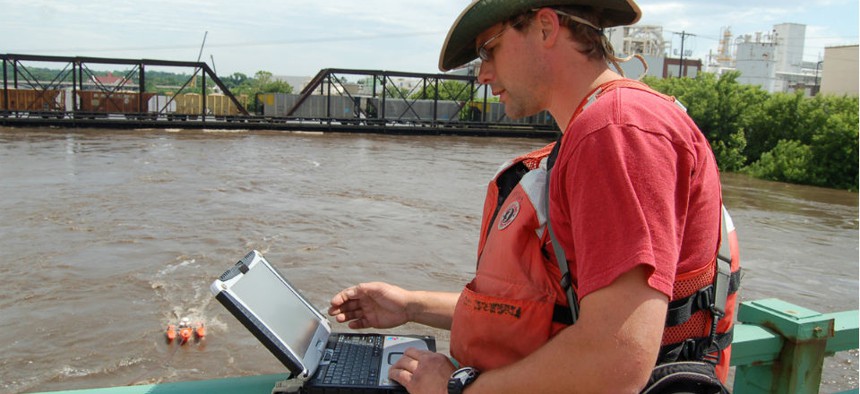
A U.S. Geological Survey employee monitors the Iowa River in Cedar Rapids during the 2008 flood. Don Becker/USGS file photo
Taxpayers Are Out $12M for Rebuilding Following 2008 Iowa Flood
FEMA failed to follow guidelines on replacing versus repairing damaged buildings, watchdog finds.
The decision to repair or replace damaged property is supposed to turn on “the 50 percent rule,” a threshold in cost estimating above which a building or transport facility should be funded for complete rebuilding.
But the Federal Emergency Management Agency did not follow that guidance when it responded to the 2008 record river flooding in Cedar Rapids, Iowa, according to a report issued Thursday by the Homeland Security Department inspector general.
When the Iowa River crested on June 13, 2008, the flooding over 10 square miles of the town devastated the main library, two animal control facilities and a park maintenance shop among other property. Overall, 310 city facilities and 5,390 homes were hit, dislocating more than 18,000 residents.
FEMA subsequently allocated $20.6 million in federal disaster relief funds to replace the four facilities, when, according to the IG’s probe, the buildings could have been repaired for $8.57 million. “FEMA needs to improve and refine its calculations in regard to repairing or replacing damaged facilities,” Inspector General John Roth said. “We have made several recommendations that will assist FEMA in that process and hopefully prevent misspending on disaster relief.”
Specifically, the IG said FEMA had inappropriately included emergency protective measures—called “muck-out costs”—in the estimate, while leaving off the cost of National Flood Insurance Program elevation requirements for the replacement structures.
Regional FEMA officials disagreed, arguing that the classification of the emergency measures is less important than what the work in the end accomplishes. City officials also disagreed with the IG’s rationale, saying the costs shouldn’t be questioned, the report said.
The IG stressed that it found no evidence that the city misrepresented the conditions or costs of restoring the buildings, and that the regional FEMA planners had taken corrective actions to better follow the rule in the future.







